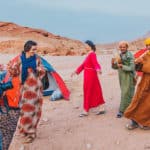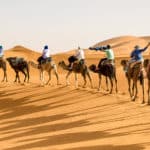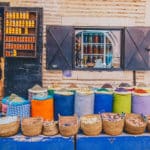Best of Morocco
If you’re looking for a two-week adventure full of Morocco’s highlights, this trip is for you! From sacred sites and bustling medinas to the expanse of the Sahara, you’ll be hitting all the popular hotspots and stopping for air in some of the country’s best scenery. Wander in the lanes of the blue city Chefchaouen, explore the Roman ruins of Volubilis and find the cultural heart of Morocco in Fes. Drive through everchanging scenery (look out for Barbary apes and nomadic shepherds along the way), ride a camel towards a desert sunset, hike through lush palm groves in Todra Valley, discover popular filming locations in World Heritage-listed Ait Benhaddou, kick back and unwind in seaside Essaouria and top it all off with the street food bazaars and performers in Djemaa el-Fna Square in Marrakech.
15 days, from
$1,136
per person
GROUP SIZE
ACTIVITY LEVEL
Details
Countries Visited:
Morocco
Accommodation: Camp site (1 night), Gite homestay (1 night), Guesthouse (1 nights), Hotel (11 nights)
Transportation: Private Bus , Public bus , Taxi , High Speed Train
Included Meals:
- 14 breakfasts
- 1 lunches
- 3 dinners
Group size: Minimum 1, Max 16
Minimum Age: 15
Under the eye of a local tour guide, feel like you've travelled back to the Middle Ages in the labyrinthine medina of Fes.
Stay in a traditional Berber homestay high in the Atlas Mountains, to better understand the culture and tradition of an indigenous population who have stood the test of time.
Take the opportunity to trek through the dramatic red dunes of the Sahara on a camel, experiencing an unforgettable sunset experience.
Kick back in the coastal town of Essaouira and discover at your own pace, enjoying a fresh seafood barbecue on the waterfront.
Marrakech’s Djemaa el-Fna is a city within a city. Explore one of the world’s largest meeting places, joining the night’s carnival atmosphere of fortune-tellers, dancers, and medicine men.
Itinerary
Salaam Aleikum! Welcome to Morocco. Your adventure begins today with a welcome meeting at 6 pm. As there's little free time included in Casablanca on this trip, to fully explore the city consider coming a day or two earlier. Modeled after Marseille in France, the city is famous for its art deco buildings and the modern-day masterpiece, the Hassan II Mosque. A pleasant way to spend the day exploring Casablanca is to wander the old medina and the city walls, then jump in a taxi to visit the Quartiers des Habous, the new medina. Finish the day with a walk along the Corniche, watching the locals play football on the beach, or take it easy with a glass of sweet mint tea in one of the many great cafes. It’s very important that you attend the welcome meeting as we will be collecting insurance details and next of kin information at this time. If you are going to be late please let your travel agent or hotel reception know. Ask reception or look for a note in the lobby for more information on where the meeting will take place. If you can't arrange a flight that will arrive on time, you may wish to arrive a day early. We'll be happy to book additional accommodation for you (subject to availability).
Today take an early morning 1-hour train to the historical town of Rabat. Rabat's history is long and colourful, having been host to Roman settlements, pirates, and more recently the Moroccan parliament. It contains many fine Arab monuments, some dating from the 10th to 15th century Almohad and Merenid dynasties, and others that are far older. The earliest known settlement is Sala, occupying an area now known as the Chellah. Store your luggage and spend a few hours strolling through the city's old quarter, then walk up to Kasbah des Oudaias and enjoy views over the Atlantic Ocean. Afterward, continue to Meknes on a 3-hour train. The imperial city of Meknes was built when Sultan Moulay Ismail (a contemporary of Louis XIV) set out to create his own version of Versailles, using over 25,000 slaves to construct walls, gates, and over 50 palaces.
This morning is free for you to explore Meknes. In the 17th century, Sultan Moulay Ismail turned Meknes from a provincial town to a spectacular Imperial city – visit his immense Heri es Souani Granary, a mammoth architectural feat, and the city's now crumbling imperial palaces. Also, why not try a camel burger for lunch at a friendly local restaurant in the medina? Later, board a private minibus and travel for 1 hour through rolling hills and olive groves to the archaeological site of Volubilis. This was once a provincial Roman capital, a distant outpost of the empire, and the remains make an undeniably impressive sight. Upon arrival, take a tour around the ruins with a local guide. Please remember to pack drinking water, hat, sunglasses, and sun cream for this tour as it may get hot and you will be exposed to the sun. And, of course, don’t forget to take your camera as the town is filled with fantastic mosaics along the Decumanus Maximus, many of which remain intact. Afterward, make the 2-hour drive to Fes, where you'll spend the next two nights. Fes is the spiritual and cultural heart of Morocco – vibrant, noisy, fascinating and overwhelming. It is a feast for the senses, with a huge, well-preserved medieval old city that’s the mother of all medinas.
Take a guided group walking tour of the old city, known locally as Fes el Bali. Step back into the Middle Ages in the labyrinth of the Medina, which is alive with craftsmen, markets, tanneries and mosques. Pass donkeys piled high with goods (this is one of the largest car-free urban zones in the world) and explore the specialty sections that divide the souk. Look out for the Medersa Bou Inania: one of the city's most beautiful buildings, which has recently been restored and is now open to tourists. Visit Medresse el Attarine and the splendid Funduk Nejjarine: a beautifully restored 18th century inn. You'll also see the famous tannery, known for the iconic view overlooking its dye pits, and a ceramics factory where you can see potters working in the traditional way. In the evening, why not get your group together and try out some Moroccan specialities like harira (chickpea soup) and chicken-stuffed pastilla with couscous.
Board a private minibus and leave the intensity of the city behind for the simplicity of the scenic Middle Atlas Mountains (approximately 5 hours). Drive south and inland through a variety of spectacular scenery – fertile valleys and forests contrasted with barren, rocky landscapes. The area is populated with wandering nomadic shepherds attending to their flocks. Pass through cedar forests which are home to Barbary apes, North Africa's only monkey, and on to your destination of Midelt. Nestled in a valley, Midelt is a market town, originally built as a base for mining in the area and surrounded by farmland and orchards. Stretch your legs as you explore the nearby village of Berrem and take a closer look at local farming life. You could also check out an optional traditional music performance in Midelt. Tonight, stay at Ksar Timnay. This terrific accommodation is inspired by a traditional kasbah (type of medina or fortress) and is an ideal base for your tour through the Middle Atlas – especially with a large pool to cool off! Relax in the large rooms and be ready for some desert trekking tomorrow.
Today it's a 6-hour drive towards the mighty Sahara. Since we'll have the convenience of our own private minivan, there will be many opportunities to stop and admire views of kasbahs and palmeries (valleys lush with date palms, fields, and orchards). You may also have the chance to pass by Nomads on their journey – these free-spirited people are born to move with their animal flocks under the open sky, and never stay settled in one place for too long. Continue to drive through changing scenery, from barren mountainsides to fertile valleys, pausing in frontier towns like Erfoud and Rissani, before reaching the end of the road at the small Saharan settlement of Merzouga. With a backdrop of the orange-coloured Erg Chebbi sand dunes, the charming Saharan village of Merzouga feels wonderfully isolated, like the modern world has left it behind. Store your main baggage in your overnight camp on the edge of the desert and mount a camel for a 1-hour sunset ride into the desert. The Erg Chebbi dunes are the most stunning in the country and an essential part of any visit to Morocco. An erg is a vast sea of shifting wind-swept sand that's formed into picturesque, undulating crests and valleys. Located at the end of a sealed road and just 20 kilometres from the Algerian border, this really feels like a frontier country. Spend the night in a desert camp under the stars. Our local friends will prepare a hearty feast, so all you need to do is sit back and relax.
Walk up the nearest dune for a spectacular sunrise over the Sahara, break your fast with traditional food, and begin the drive to Todra Gorge. On the way visit the oasis museum of El Khorbat, before continuing on to the beautiful Todra Valley (approximately 5 hours in total), which follows the foothills of the Atlas Mountains and is dotted with mud-brick villages perched on hillsides. The remarkable scenery – sprawling green valleys and rocks sculpted into stunning formations by the wind – will be your home for the next two nights. This area is best discovering on foot, so you’ll take a short walk through the surrounding farmland and a ruined village.
Today enjoy free time to explore the Todra Valley. A guided hike through the gorge and over a nearby mountain pass is highly recommended. There are a couple of circuits to choose from, but the most popular choice is a 10-kilometre circuit that will take around 4 hours. Accompanied by a local guide, you’ll walk a trail that undulates slightly here and there, but isn't too challenging if you have a moderate level of fitness. On the walk you'll pass Berber villages, meeting local Berbers along the way and perhaps having a chance to share a cup of mint tea. The surrounding mountains and the famous Rose Valley in the distance make a sensational setting. To fully enjoy the walk, ensure you have walking boots or sturdy trainers, sunglasses, sun cream, and plenty of water. For lunch, you can join some local ladies in their mudbrick kasbah – a fantastic opportunity to see how people live in this largely unchanged culture. Otherwise, a simple lounge by the hotel pool with views over the lush palmeries and soaring cliff faces is also a great way to spend your day.
Today travel south for 4 hours to Ait Benhaddou. The scenic drive will take you past ancient kasbah ruins, former colonial military outposts, austere mountains, and valleys of palm trees and irrigated fields. Pause for lunch in Ouarzazate, where movies such as Lawrence of Arabia, The Sheltering Sky, and Black Hawk Down were filmed. Time permitting, you may also have time to take a tour of the Atlas Movie Studios. Afterward, continue on to your destination of Ait Benhaddou. Centuries ago, this was an important stop for caravans carrying salt across the Sahara. Today, its grand kasbah, a fine example of clay architecture, has been listed as a World Heritage site. In the late afternoon, why not enjoy Morocco's most famous cuisine: couscous and tagine.
Bid farewell to the Sahara and journey over the spectacular Tizi n'Tichka Pass (2260 metres above sea level) to Toubkal National Park (approximately 5 hours), passing snow-dappled mountains and valleys in full flower along the way. At the end of the road in Imlil, store your main luggage and load a daypack onto a pack mule. Walk into traditional mountain village life with a 1-hour trek up to the peaceful village of Aroumd; far from the reach of the modern world. If you don't feel comfortable with the walk, you can ride a mule instead. Perched on a rocky outcrop, the remote village of Aroumd offers stunning views across the High Atlas Mountains and a unique opportunity to experience traditional Berber culture, and as such, you’ll spend the night in a family-run mountain home (gite). Surrounded by the smell of woodstoves and bread, meet the host family and enjoy Berber hospitality and food.
Take a morning walk through the valleys and trails of the stunning Atlas Mountains (weather depending). Later on, head westwards for around 5 hours towards the Atlantic Coast and the old fishing town of Essaouira: a city where the medina brushes up against the Atlantic Ocean. Sandstone walkways contrast with whitewashed houses, bright blue sky, and the sand of the surrounding beaches and dunes. This artists' town was once home to sizeable British and Jewish populations, and its charm has seduced people like Orson Welles and Jimi Hendrix, who (according to local legend) spent much of his time here in the 1960s. As you will arrive in the afternoon, there will be still some time for exploring. Your tour leader will guide you through some options for the rest of the day. Observing the daily seafood auctions is always a fun thing to do, but otherwise, visit one of the small local cafes and do a spot of people watching. In the evening, perhaps catch up with your group to share a meal and discover this lovely town by night.
Today, join a local guide for a walking tour through the old medina, Jewish mellah, port, and skala (sea wall). Afterward, use your free time to get under the skin of the town. The narrow streets of Essaouira are ideal for walking. Their size discourages cars, and on a walk through the town, it feels as though little has changed since the days of sea pirates. Browse the plentiful shops and intriguing art galleries that make this little town a particularly pleasant place to unwind for a few days. It has a growing reputation for its unique art and is becoming even more famous for its burled Thuya wood, delicately formed and inlaid in tiny shops that are built into the thick walls of the Portuguese ramparts. The scent from the oils used to polish the richly coloured wood permeates the air and makes walking down the streets incredibly pleasant. For lunch, why not order a freshly cooked plate of the day’s seafood? There are so many places to enjoy this on the seaside. Later on, if you’d prefer to relax, don't miss the opportunity to indulge in a hammam or local-style bath.
Have a casual chat with locals on a 3-hour shared bus ride to Marrakech: an ancient, exotic city wrapped in European modernity. Marrakech is a feast for the senses. Be enticed by the alluring scents and brilliant colours of the spice markets, the sounds of the musicians, the rich folds of carpets, delectable foods, acrobats, and perfumed gardens. Perhaps join the thronging crowds for dinner at the famous Djemaa el-Fna: one of the largest public spaces in the world and unique to Marrakech. When night falls on this square it transforms into a hive of activity. Henna-painters, performers, and storytellers share the square with a street food bazaar, packed with stalls loaded with Moroccan delicacies, including snail soup! You could enjoy a bite of famous Moroccan pastries with a glass of freshly squeezed orange juice, and then finish your evening with a cup of tea on one of the roof-top restaurants overlooking the square.
It’s time to explore Marrakech at your own pace. Explore the Medina for some last-minute shopping, where every step brings a new smell, a new sight, or a new gift to buy. In the seemingly endless mosaic of souqs, each is devoted to a separate trade: pottery, woodwork, copper, leather, carpets and spices. Watch skilled artisans perfect their craft, practice your haggling skills, or take a break from the hustle to sip on tea or share a tajine, filled with the pure scent of Morocco. Otherwise, you could visit the well-known Koutoubia Mosque and its 12th-century minaret, which was the famous prototype for the Giralda tower in Seville. Take a wander through the tropical gardens of the French painter Jacques Majorelle (now owned by Yves Saint Laurent). You might like to check out the Palais Bahia, a superb example of Muslim architecture, or the ruins of the Palais Badi, reputedly one of the most beautiful palaces in the world in its time. The Saadian tombs are a recently uncovered gem of the Medina. All of the above can be a challenge to locate, but that's all part of the experience of exploring the medinas of Morocco. This evening you will likely be drawn back to the Djemaa el-Fna and its surrounding medina. Eating out at one of the many outdoor restaurants lining the square is a great way to wrap up the day!
With no activities planned for today, you are free to leave at any time. Check-out time is usually around midday, however, if you wish to spend more time in Marrakech, we can organise additional accommodation for you (subject to availability).












